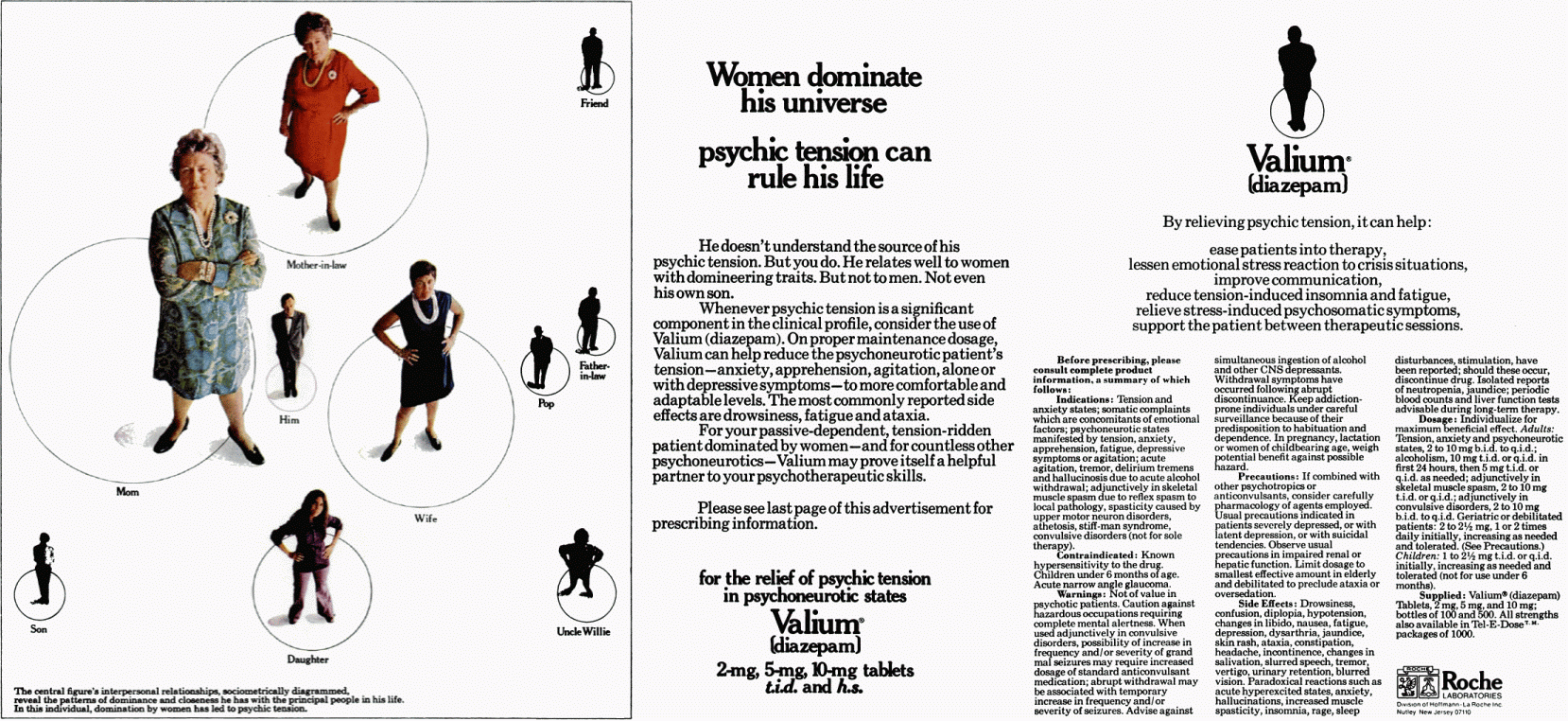

|
|
Valium advertisement, 1970. Hospital & Community Psychiatry, Vol. 21, No. 4. Women dominate his universe ~ Psychic tension can rule his life Mom ~ Mother-in-law ~ Wife ~ Daughter ~ Friend ~ Pop ~ Father-in-law ~ Uncle Willie ~ Son The central figure's interpersonal relationships, sociometrically diagrammed, reveal the patterns of dominance and closeness he has with the principal people in his life. In this individual, domination by women has led to psychic tension. He doesn't understand the source of his psychic tension. But you do. He relates well to women with domineering traits. But not to men. Not even his own son. Whenever psychic tension is a significant component in the clinical profile, consider the use of Valium (diazepam). On proper maintenance dosage, Valium can help reduce the psychoneurotic patient's tension -- anxiety, apprehension, agitation, alone or with depressive symptoms -- to more comfortable and adaptable levels. The most commonly reported side effects are drowsiness, fatigue and ataxia.. For your passive-dependent, tension-ridden patient dominated by women -- and for countless other psychoneurotics -- Valium may prove itself a helpful partner to your psychotherapeutic skills. Please see last page of this advertisement for prescribing information. for the relief of psychic tension in psychoneurotic states VALIUM® (diazepam) 20mg, 5-mg, 10mg tablets t.i.d. and h.s. By relieving undue psychic tension, it can help: ease patients into therapy, lessen emotional stress reaction to crisis situations, improve communication, reduce tension-induced insomnia and fatigue, relieve stress-induced psychosomatic symptoms, support the patient between therapeutic sessions. Indications: Tension and anxiety states; somatic complaints which are concomitants of emotional factors; psychoneurotic states manifested by tension, anxiety, apprehension, fatigue, depressive symptoms or agitation; acute agitation, tremor, delirium tremens and hallucinosis due to acute alcohol withdrawal; adjunctively in skeletal muscle spasm due to reflex spasm to local pathology, spasticity caused by upper motor neuron disorders, athetosis, stiff-man syndrome, convulsive disorders (not for sole therapy). Contraindicated: Known hypersensitivity to the drug. Children under 6 months of age. Acute narrow angle glaucoma. Warnings: Not of value in psychotic patients. Caution against hazardous occupations requiring complete mental alertness. When used adjunctively in convulsive disorders, possibility of increase in frequency and/or severity of grand mal seizures may require increased dosage of standard anticonvulsant medication; abrupt withdrawal may be associated with temporary increase in frequency and/or severity of seizures. Advise against simultaneous ingestion of alcohol and other CNS depressants. Withdrawal symptoms have occurred following abrupt discontinuance. Keep addiction-prone individuals under careful surveillance because of their predisposition to habituation and dependence. In pregnancy, lactation, or women of childbearing age, weigh potential benefit against possible hazard. Precautions: If combined with other psychotropics or anticonvulsants, consider carefully pharmacology of agents employed. Usual precautions indicated in patients severely depressed, or with latent depression, or with suicidal tendencies. Observe usual precaution in impaired renal or hepatic function. Limit dosage to smallest effective amount in elderly and debilitated to preclude ataxia or oversedation. Side Effects: Drowsiness, confusion, diplopia, hypotension, changes in libido, nausea, fatigue, depression, dysarthria, jaundice, skin rash, ataxia, constipation, headache, incontinence, changes in salivation, slurred speech, tremor, vertigo, urinary retention, blurred vision. Paradoxical reactions such as acute hyperexcited states, anxiety, hallucinations, increased muscle spasticity, insomnia, rage, sleep disturbances, stimulation, have been reported; should these occur, discontinue drug. Isolated reports of neutropenia, jaundice; periodic blood counts and liver function test advisable during long-term therapy. Dosage: Individualize for maximum beneficial effect. Adults: Tension, anxiety and psychoneurotic states, 2 to 10 mg b.i.d. to q.i.d; alcoholism, 10 mg t.i.d. or q.i.d. in first 24 hours, then 5 mg t.i.d. or q.i.d. as needed; adjunctively in convulsive disorders, 2 to 10 mg b.i.d. to q.i.d. Geriatric or debilitated patients: 2 to 2½ mg, 1 or 2 times daily initially, increasing as needed and tolerated. (See Precautions.) Children: 1 to 2½ mg t.i.d. or q.i.d. initially, increasing as needed and tolerated (not for use under 6 months). Supplied: Valium® (diazepam) Tablets, 2 mg, 5 mg and 10 mg; bottles of 100 and 500. All strengths also available in Tel-E-Dose T.M. packages of 1000. Roche Laboratories ~ Division of Hoffmann-La Roche Inc. ~ Nutley, N.J. 07110 |